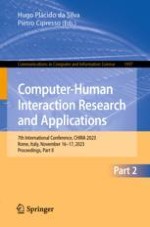These 2 volumes constitute the selected papers of the 7th International Conference, CHIRA 2023, held Rome, Italy, during November 16–17, 2023.
The 14 full papers and the 29 short papers presented in these books were carefully reviewed and selected from 69 submissions. The papers selected contribute to the advancement of research and practical applications of human-technology and human-computer interaction. Different aspects of Computer-Human Interaction were covered in four parallel tracks: human factors for interactive systems, research, and applications; interactive devices; interaction design; and adaptive and intelligent systems.
